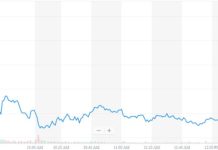[ad_1]
The first day of Swell concluded on October 15, and the program delivered on its promise to facilitate meaningful conversations about the future of digital assets, as well as the growing use case for real-time, cross-border payments for financial institutions, payments providers and corporates.
Take a look at what we’ve been up to! Watch our daily recap video.
Day one began with a keynote from Dr. Ben Bernanke, former Chairman of the Federal Reserve System (2006 – 2014). Gene Sterling, National Economic Council Director and Advisor under President Clinton and Obama, joined Bernanke on stage.
The two held a Q&A session where Sperling inquired about Bernanke’s thoughts on the current monetary policy, China’s impact on the American economy, and NAFTA trade policy.
Bernanke’s keynote drew a crowd — leaving standing room only. Many attendees gathered to be part of the intimate Q&A session and asked the former chair questions about his thoughts on blockchain technology and current threats and opportunities to the U.S economy.
Tracking Cross-Border Payments Should be as Easy as Tracking Your Pizza Order
After the keynote, the first group of panelists representing various corporates — such as GE Capital, Airbnb, and The World Bank — were joined by moderator Jeff John Roberts from Forbes to discuss the importance of transparency in cross-border global payments, and the pain points associated with not being able to track global payments.
When the topic came up, Kapil Mokhat, Global Director of Payment Programs at Airbnb, said it best: “These days you can track a pizza [being delivered], it makes sense to give that same level of transparency to tracking a payment.”
Panelists Kristin Michaud, Kapil Mokhat, Paul Snaith at Swell
Kristen Michaud, Managing Director, Treasury Operations from GE Capital echoed this sentiment, and detailed how painful it is for her organization when a payment is lost and there’s no visibility to where it is in the process.
“We were trying to send a cross-border payment, and we couldn’t get the corresponding bank to acknowledge the payment. You can imagine the hops upstream it takes to reconcile this. [This is] not an extraordinary circumstance, but you can imagine the magnitude across 180 countries,” Michaud said.
Michaud continued to explain how previous GE Capital plans to avoid these problems in the future.
“We’re entering this new era where we’re improving our capacity to track a payment through its entire journey,” Michaud concluded.
Watch the livestream to hear how Airbnb and World Bank address lost payments and where blockchain fits in to remove this friction.
Blockchain — Helping Banks Stay Competitive
The second panel featured a discussion between RippleNet customers — Siam Commercial, Banco Santander, and SBI Ripple Asia — about blockchain and the opportunities and challenges in the space. The panel’s moderator, Dilip Rao, Ripple Managing Director, APAC/MENA, led the conversation by asking the panelists why they came to Ripple and what blockchain can do for banks.
Most were trying to solve for the rapid development and innovation in FinTech services — especially around instant payments — and how they began to outpace financial services.
“We have some significant competition that have taken large chunks of the market. They offer a very good level of service. That was the trigger to improve our international payment” said Ed Metzger, Head of Innovation at Banco Santander.
Panelists Ed Metzger, Dr. Arak Sutivong, Takashi Okita at Swell
Dr. Arak Sutivong, Chief Strategy Officer, at Siam Commercial Bank, added that his organization identified that payments had “moved away from banks.”
“Technology has reshaped the banking industry in Thailand and especially payments. Payments started to go away. A lot of FinTechs started to provide payments, which prompted us to ask ourselves how do we prepare for such changes.”
“We started to look at technologies, and what blockchain and DLT meant for banks,” Sutivong said.
Takashi Okita, CEO of SBI Ripple Asia, detailed how recent regulatory changes brought together a consortium of banks — across regions — that applies blockchain for practical applications.
To hear how each panelist began using RippleNet to send global payments and won back market share from their competitors listen to the recorded livestream.
Digital Assets: Prepare for Innovation
In the final panel, Oliver T. Bussmann, Founder and Managing Partner at Bussmann Advisory, CEO of Veem Marwan Forzley, and Ripple SVP Patrick Griffin, all took the stage to discuss the lens through which they view digital assets and the practical use cases.
“There are discussions of use cases that are way out there … such as machines paying machines,” quipped Griffin.
“What is commercial and applicable today is a use case largely around treasury, cash management, and liquidity. It’s not a replacement for which money moves around, but it’s a very exciting augmentation in the back office.”
Bussmann agreed that the best use case for digital assets is in “the global payment, cash management” space because it’s rife for “disruption offers huge profit pools.”
“I view blockchain and crypto in general as providing on-demand liquidity, so you don’t have to have a bank account” added Forzley when asked by the moderator about the role digital assets play in global payments.
“It’s glue, think of it as a way to tie a bunch of local payment systems together which is typically done through corresponding banking systems. It’s a model that’s going to evolve and digital assets are at the center of it.”
To hear how the panel speculated on the limited role blockchain has to play with digital assets, watch the livestream.
Check Ripple Insights today for all of the new livestreams from day two of Swell.
(function(d, s, id) {
var js, fjs = d.getElementsByTagName(s)[0];
if (d.getElementById(id)) return;
js = d.createElement(s); js.id = id;
js.src = “http://connect.facebook.net/en_US/sdk.js#xfbml=1&version=v2.3&appId=1419450551711438”;
fjs.parentNode.insertBefore(js, fjs);
}(document, “script”, “facebook-jssdk”));
[ad_2]
Source link





